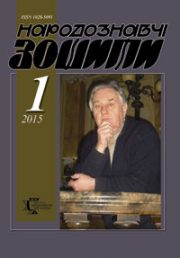The Ethnology Notebooks. 2018, 2 (140), 441—447.
UDK 39(=161.2):746.1(477.86-11)”18/192”
DOI https://doi.org/10.15407/nz2018.02.441
Received 26.02.2018
Oliinyk Olha, Candidate of Sciences in Art Studies, research fellow
Folk Art Department
of the Institute of Ethnology of the National Academy of Sciences of Ukraine.
Svobody Avenue 15, 79000, Lviv, Ukraine.
Contacts: e-mail: oliao-m@i.ua
Abstrakt. Traditional artistic fabric is one of the important markers of ethnoculture, and on the turn of the millennia, this artistic heritage becomes a powerful source of inspiration, receives new spiritual qualities. Modern aesthetic demands of society direct the development of Pokuttia weaving in the framework of the interpretation of the traditional artistic basis, the creation of figurative associations by masters and textile designers.
Keywords: fabric, tradition, folk artist, pattern, ornament.
REFERENCES
Myhailova, Marina.(2011). Etnokultura ta natcionalna svidomist’: socialno-filosofs’kyi analiz. Naukovi zapysky Natsionalnogo universytetu «Ostroz‘ka akademia». Seria «Filosofia». 8, 19—27. Ostroh: Ostroz’ka akademia [in Ukrainian].
Smit, E. (2009). Natsiji ta nacionalizm u globalnu epohu. (E.Smit; per. z angl. M.Klymchuka I T.Tsymbala). Kyiv: Nika-Centr [in Ukrainian].
Natcionalnyj muzej narodnoho mystectva Huculshchyny i Pokuttya. Retrieved from: http://hutsul.museum/museum/articles/mustectvo-pokyttya/).
Natalia Hrytsak. «TeksStyl. Dynamika tradytsiji». Retrieved from: http://hutsul.museum/exhibitions/ 2013/Tekstul-dynamika-traduciya/.
Jaroslava Tkachuk. Mystetstvo Pokuttya. Retrieved from: http://hutsul.museum/museum/articles/mustectvo-pokyttya/.
«Pokutske tkatstvo» rodyny Kostyukiv. Retrieved from: http://www.ifportal.net/news/full/11690.html.
Tkastvo Mariyi Stefak. Retrieved from: https://tkactvo.webnode.com.ua/.
Olya Polyuk, Nataliya Hrytsak «Dorohy, shcho pereplelysia». Retrieved from: http://hutsul.museum/exhibitions/2014/lytvyn-sachro-tekstyl/.
Oksana Lytvyn: «Po zhyttyu vede Boh, I vid nas nichogo ne zalezhyt. Retrieved from: http://kuryer-if.info/oksana-litvin-po-zhittyu-vede-bog-i-vid-nas-nichogo-ne-zalezhit/.







